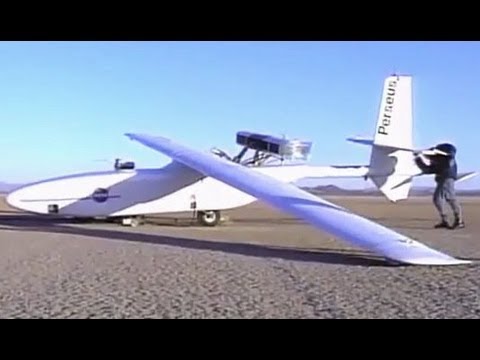more at
“This video documents efforts of NASA Dryden Flight Research Center to develop and utilize ultra-light, remotely piloted gliders to study Earth’s atmosphere. The advantage of these vehicles is that they are inexpensive, and can fly at altitudes twice that of commercial airlines.”
Public domain film from NASA, slightly cropped to remove uneven edges, with the aspect ratio corrected, and mild video noise reduction applied.
The soundtrack was also processed with volume normalization, noise reduction, clipping reduction, and/or equalization.
The Environmental Research Aircraft and Sensor Technology, or ERAST program was a NASA program to develop cost-effective, slow-flying unmanned aerial vehicles (UAVs) that can perform long-duration science missions at altitudes above 60,000 feet. The project included a number of different technology development programs which were conducted by the joint NASA-industry ERAST Alliance. The project was formally terminated in 2003…
Program overview
According to NASA, “ERAST is a multiyear effort to develop the aeronautical and sensor technologies for a new family of remotely piloted aircraft intended for upper atmospheric science missions. Designed to cruise at slow speeds for long durations at altitudes of 60,000 to 100,000 ft, such aircraft could be used to collect, identify, and monitor environmental data to assess global climate change and assist in weather monitoring and forecasting. They also could serve as airborne telecommunications platforms, performing functions similar to communications satellites at a fraction of the cost of lofting a satellite into space.”
“The ERAST program is sponsored by the Office of Aeronautics and Space Transportation Technology at NASA Headquarters, and is managed by NASA Dryden Flight Research Center. The NASA Ames Research Center, Moffett Field, California, heads the sensor technology development. The NASA Lewis Research Center, Cleveland, Ohio, and NASA Langley Research Center, Hampton, Virginia, are contributing expertise in the areas of propulsion, structures, and systems analysis. Several small high-technology aeronautical development firms, including ALTUS developer General Atomics Aeronautical Systems, Inc., are teamed with NASA in the ERAST Alliance to work towards common goals of the program.” Industry partners in the ERAST Alliance included Aurora Flight Systems, AeroVironment, General Atomics, Scaled Composites, Thermo-Mechanical Systems, Hyperspectral Sciences, and Longitude 122 West.
The types of science mission which ERAST prepares for can include remote sensing for Earth sciences studies, hyperspectral imaging for agriculture monitoring, tracking of severe storms, and serving as telecommunications relay platforms…
Aurora Flight Sciences specializes in the design and construction of unmanned aircraft. Aurora has been established for 20+ years and their headquarters was at the Manassas Airport in Manassas, VA, but is now located in Cambridge, MA…
History
The company was founded in Alexandria, Virginia, in 1989 as a follow on to the MIT Daedalus Project. The first aircraft was the Perseus proof of concept (POC) built for NASA which first flew in 1991 at NASA Dryden. It was followed by two Perseus As and one Perseus B which were all built for NASA’s ERAST program. A twin engine Theseus was also built.
In 1995 Aurora joined the Global Hawk team and continues to build composite fuselage components and tail assemblies of the RQ-4 for Northrop Grumman and the United States Air Force.
Aurora has been involved in several NASA programs studying how to fly an aircraft on the planet Mars. A demonstration aircraft was flown in 2002 from an altitude of 100,000′ to simulate the low density of the martian atmosphere.
Aurora has developed its own line of small vertical take-off UAVs known as GoldenEye. The third variant of this family, the GoldenEye-80, was first flown publicly at AUVSI’s 2009 Unmanned Systems North America trade show…
Aircraft Produced
– Perseus POC
– Perseus A
– Theseus
– Perseus B
– Chiron
– MarsFlyer
– GoldenEye 100
– GoldenEye 50
– GoldenEye 80
– Excalibur
– Orion
– SunLight Eagle
– Odysseus…

